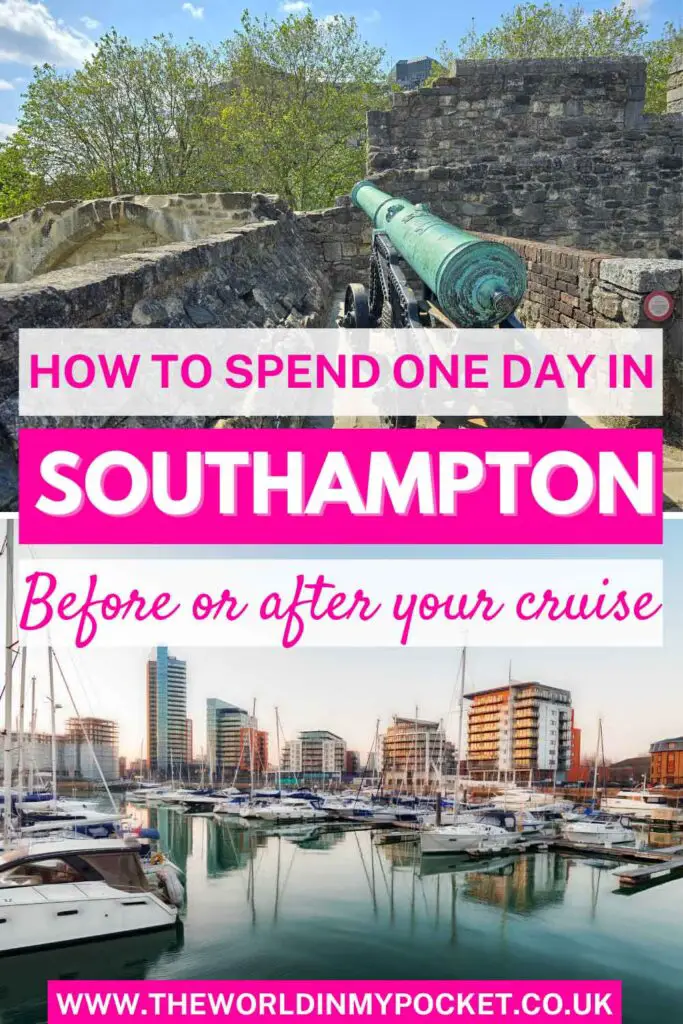Despite living relatively close to Southampton and driving by it many times, I never actually visited the city. Until this weekend, when I decided to spend a spontaneous day in Southampton and discover what the city has to offer. In the end, it’s the major cruise ship harbour of England, where thousands of people embark on their journeys by sea every day. It’s also the famous port from where the Titanic sailed on its maiden voyage to New York.
I was curious to see what’s there to do in Southampton when you only have one day available, before embarking on a cruise ship. Many people arrive the day before their cruise and spend the night in Southampton.
Southampton as a Cruise Port

Southampton is one of the busiest cruise ship ports in the UK. It has five cruise terminals (City Cruise, Horizon, Mayflower, Ocean, and QEII) and often you will spot at least one large cruiser anchored, waiting to depart for sunnier places. If you are booking a cruise departing from England, it is more likely that you will have to travel to Southampton. The harbour caters for all types of cruises and ships. It doesn’t matter if you are embarking on a two-week cruise or just came back after your mini cruise, you will find yourself in Southampton.
The city’s maritime heritage goes a long way in time, before the Titanic. During medieval times the city was an important trade hub, especially for French wine and English wool.
Southampton is relatively close to London, with direct connections from London Waterloo station. The city has its own airport as well, which is mostly served by internal flights.
How to Spend a Day in Southampton
Enter the City through the Bargate

I arrived in Southampton just before lunchtime and parked the car in the Eastgate multistorey car park, which is very centrally located. The fee for 10 hours of parking is £7.
I began my visit to Southampton by entering through the Bargate, the medieval gate that used to receive visitors to the city in the past. Built in 1180 this medieval gatehouse now sits in the city centre of Southampton. Made of stone and flint, this impressive gate was built during the Norman times to keep intruders out. The gate separates High Street on the south side from Above Bar Street to the north. Bargate was equipped with three guns to defend the town. By 1320, drum towers were added to either side of the central archway and the upper floor was extended, to act as a Guildhall.
See the Holyrood Church Ruins and the Memorial Fountain RMS Titanic

Walking down the road towards the harbour, I stumbled upon the ruins of Holyrood Church, which was actually not on my original itinerary.
Erected in 1320, the church was initially known as the Church of the Sailors. Just two decades after being built the church came under attack by Genoese and French forces who raided the city damaging the church building. The ruins of the church today remain a memorial to those who served in the Merchant Navy and lost their lives at sea. The church ruins currently also house a tall ornamental fountain with a small relief of the RMS Titanic at the top. This fountain made of Portland stone was originally placed in the Avenue at the entrance to the Common. However, it was moved to Holyrood Church Ruins in 1972.

Inside the ruins, there are two audio installations where I could listen to testimonies of people who witnessed the bombing of the church, as well as stories of survivors from the Titanic. It was the only monument in Southampton where I found these audio descriptions, which I thought were so insightful and gave so much content to the ruins of the church.
See St Michael’s Church

Just across the street from the to Holyrood Church Ruins, I spotted St Michael’s Church, with its impressive spire.
Known as one of the oldest buildings in Southampton, St Michael’s Church dates back to 1070 when the city was still being built by the Normans. Initially, the church was much smaller than what it is today, with the tower at the centre of a simple cross-shaped building. Two chapels were added in the 13th century on either side of the high altar while the spire was built in the 15th century and rebuilt again in 1732. The height of the spire was later heightened in 1870. The church underwent various renovations to accommodate more worshippers. Miraculously this is the only parish church in the centre of the town that escaped the bombing of the city in 1940.

Unfortunately on Saturday, the church was closed and I couldn’t visit the interior. The church is run by volunteers and outside of the mass, it is open depending on their availability.
Visit the Tudor House and Have a Cup of Tea in the Garden

Standing right opposite St Michael’s Church, Tudor House remains one of the prominent buildings that reveals over 800 years of history. Built in 1491, this timber-framed building internally connects to King John’s Palace, an 1100-year-old Norman house, via Tudor House Garden. The house now turned into a museum offers a good insight into the lives and times of the residents and of Southampton itself.

The garden of the house hosts a charming café which serves hot and cold drinks, as well as sandwiches and soup for lunch. I couldn’t help but get a cup of tea, sit down at an outdoor table, and enjoy the garden, which was in full bloom.

Now, the garden itself is worth visiting, even if you don’t go inside the house (which costs £7). At the back end, there is a small archway, leading to a private part of the city walls where sits an original cannon made in 1542 by Arcanus Of Cesna for Henry VIII. The cannon is in a fantastic well-preserved condition.
See the Medieval Merchant’s House

Built in 1290, by a wealthy merchant John Fortin, the Medieval Merchant’s House is on one of the busiest streets in Southampton well within the medieval town wall. For many centuries, this property was used for residential and commercial purposes. The building has architectural importance because it is the only building of its type that has survived and remained as first built. While the interiors were damaged during a German bombing in 1940 the property has been restored and open for tours.
However, during my trip, it wasn’t open so I could only see it from the outside.
Have Lunch at the Duke of Wellington

For lunch, initially, I wanted to go to the famous Dancing Man Brewery, but they weren’t serving any food at that time. So I returned to the Duke of Wellington, just up the road.
The Duke of Wellington is a historic pub serving traditional British food and ales, that dates from the 12th century. They were fully booked inside, so I sat down at one of the wooden tables in front, sharing with a guy who was enjoying a pint and a book, in the sunshine. Benedict Ace, one of the early mayors of Southampton owned the property initially. The property was damaged in the French raid of 1338 but in 1940, a brewer named Rowland Johnson incorporated the house into the current building and named it Bere House. After the Battle of Waterloo, the inn’s name was changed to the Duke of Wellington.
As I was pretty hungry, I went for a burger, whilst my friend chose the lasagna. They were both very delicious, and the portions were quite large for the price we paid.
Have a Drink at Dancing Man Brewery

The day was absolutely glorious, with the first rays of sunshine I’ve seen in a while here in the UK. Yes, we’ve had a ridiculous amount of rain this spring. So, I couldn’t not have a pint at the Dancing Man Brewery. Especially since it was packed with people enjoying the sunshine, and having their drinks on the grass, outside the brewery.
Owned by 2 friends and their team, Dancing Man Brewery is an independent award-winning brewpub that crafts its ales. Voted as the Best Pub in Southampton, this 110-seater restaurant is a great place offering excellent food for lunch and dinner. Just make sure that you arrive during the food serving times, not outside of them, like me.
Follow the Jane Austen Trail

While you are in Southampton you can also follow the Jane Austen Trail which takes you across various important streets in the city. The trail initiates at The Bargate where you can read a plaque mentioning Jane’s first visit to Southampton as a schoolgirl followed by All Saints Church where she worshipped. Subsequently, you can explore The Spa Gardens and Jane Austen’s House which now houses Juniper Berry Pub. The Long Rooms and Hot Baths, the Theatre Royal, The Water Gate, The Platform and The Dolphin Hotel complete the trail.
Walk the City Walls

The north and the west sides of Southampton still have the medieval town walls that once protected the city from foreign intruders. Hence, when you are in Southampton you can still walk the city walls and explore various historical sites.
The Watergate Ruin: Also known as West Gate and Water Gate, this historic gatehouse overlooked the crowded port area and ships arriving from different parts of Europe. The gatehouse was built in 1337 and was responsible for collecting tolls from incoming ships into the port. While much of the structure is eroded, it remains a popular historical site to explore while walking the Old Town route.

Weigh House: Located on French Street, the Weigh House was used for storing the royal Tron, or weigh beams, scales and weights. It was also called Poysage House and was used to weigh wool for customs before it was sent across Europe from Southampton. By the late 1500s, it was used to store potatoes, onions, coal and ice. The building was burned down in 1940 in Southampton Blitz but the shell has been restored multiple times.
Canute’s Palace: Formerly known as the Long House, Canute’s Palace was built between 1170 and 1200. The place was a Norman merchant’s house. Hence, historically there is no association with Canute the Great. Additionally, it was just a Norman mansion and not a palace as the name suggests.
The Westgate: Once standing at St Michael’s Square, The Westgate was one of the important gates into the medieval town. Built after the French Raid of 1338, Henry V’s army departed through Westgate in 1415. In 1620, the Mayflower and sister ship Speedwell passed through the Westgate on their way to America.

Cuckoo Lane: Before the French Raid of 1338, Cuckoo Lane was a posh area home to wealthy merchants. After the raid, the homes were demolished to erect town walls. In the late 1700s, the prisoners of the Spanish wars who died in captivity in Wool House were buried here.
God’s House Tower and Seeing Things Differently Exhibition (Temporary)

Named after the God’s House Hospital, God’s House Tower was designed to defend the medieval town from foreign intruders. It also doubled as town armoury with the gunner living on the first floor. The tower also has gun ports which are visible around the building. In the 1780s, Debtors Prison and Felons Gaol were housed in this ancient fortification.
Today, the ground floor of the tower is home to a café whilst the first floor is an exhibition creative space, free to visit. From May 31, 2024, to June 16, 2024, you can also visit the See Things Differently exhibition, which I’ve visited. It focuses on work produced by young adults between the ages of 16-25 years old, showing their creativity with a camera.
See the Titanic Plaque Memorial

The Titanic Plaque Memorial is a simple memorial dedicated to the crew and passengers of the Titanic. The memorial was originally unveiled outside the Associated British Ports building. However, due to security measures at the docks, the memorial was relocated in front of the former dock’s post office, to allow visitors to have a better look at it.
Go Shopping at WestQuay

If you are a shopaholic, shopping at WestQuay can be quite an experience. This is a premier shopping destination in Southampton housing more than 100 retail shops, restaurants, cafes and a cinema hall. It is also conveniently located a few minutes walk from Southampton Central station.
Enjoy a Magic Experience at Dark Arts Potion Bar

To finish our day in Southampton, we stopped at the Dark Arts Potion Bar, which I eyed early, whilst trying to find the car park. Unfortunately, it was fully booked for the magic experience, but we could still grab a mocktail on the terrace, outside. I will definitely be back to try to full experience, and if you want to do it as well, I highly recommend booking ahead. This place is out of this world!
Conclusion
I really enjoyed my day out in Southampton. I discovered a great city, which is so much more than just a cruise harbour. And with such a beautiful sunny day, it was nice to see its locals out and about, bringing the streets to life.
So, if you have a day to spare before or after your cruise, Southampton will surprise you with all it has to offer.
For more similar articles about United Kingdom, check out my recommendations below:
- How to spend a day in Portsmouth
- How to spend a day in Windsor
- How to spend a day in Canterbury
- How to spend a day in Cambridge
Like it? Pin it!

Disclaimer: Some of the links on this website are “affiliate links.” This means that if you click on the link and do a purchase, I will receive an affiliate commission at no extra cost for you. This helps me keep my website running and continue to share my travelling knowledge with you. I thank you for booking your flights or hotels using the links on my website. Regardless, I only recommend products or services I use personally and believe will add value to my readers.





This looks lovely, and any town by the sea gets my vote! Unfortunately I never made it to Southampton, having been a Northern transplant… I will put this on my wish list, because I heard there are many lovely places to sail there as well?
This is such a fruitful itinerary for just one day! I’d definitely go insane at the Medieval Merchant’s House – it’s 5000% up my alley 🤩🤩
I docked at Southampton on my way to Yorkshire and loved the city can’t wait to get back there.
What a great way to spend a day in Southampton. I’ve done some while I visited, but not all. The Dark Arts Potion Bar looks so cool!
We’ve looked at going on a few cruises out of Southampton, so I’m glad to learn a little bit more about the area!
I’m in the middle of researching wether to get a ferry from Portsmouth or Southampton I think this may have just swayed my decision
I like the idea of walking the Jane Austen Trail and the city walls.
In 1968, when I was 18, I worked on the American passenger liner SS United States – not a cruise ship, but rather a mode of transport, sailing from NYC to Southampton, Le Havre, Bremerhaven – back and forth. Jet travel to Europe was new and not yet common; tourists going to Europe (or returning) or families with a parent going to take a job in the European office of their US company made up the passengers (with their cars travelling in the hold). I remember docking in Southampton, and going ashore, passing through the medieval gate, and going to have some pub grub, before returning to the ship for a 5 am departure the next day.
Thank you so much for sharing your story. I would have loved to be on one of those ships that had the pure purpose of connecting the States with Europe. I can imagine the trip was so much different than it is now.